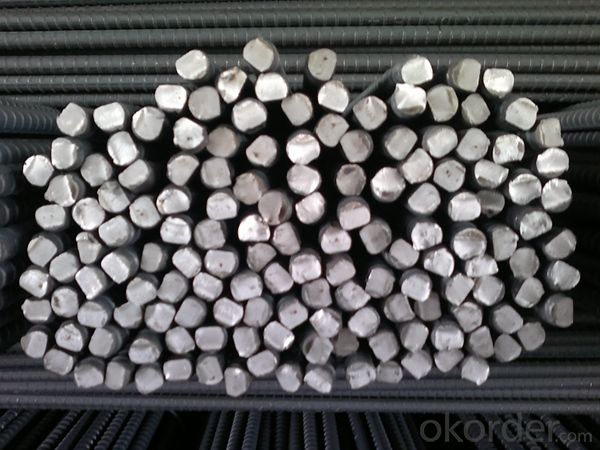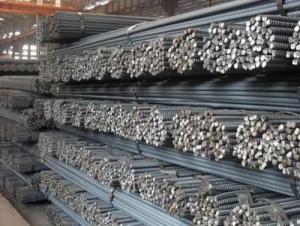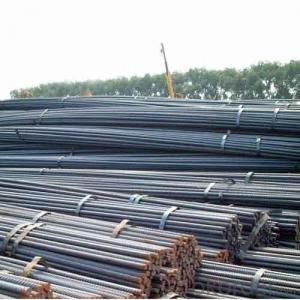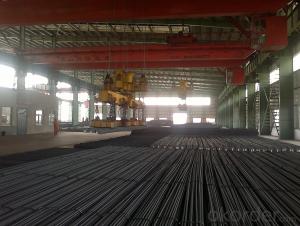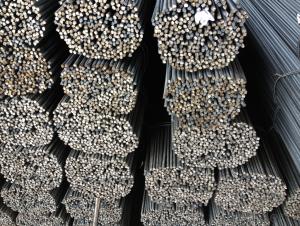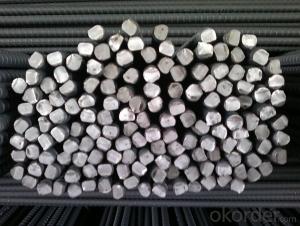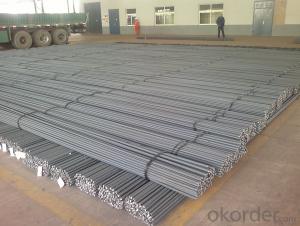Hot Rolled Deformed Steel Rebars for Construction ASTM GR40, 60
- Loading Port:
- Tianjin
- Payment Terms:
- TT or LC
- Min Order Qty:
- 25 m.t.
- Supply Capability:
- 200000 m.t./month
OKorder Service Pledge
OKorder Financial Service
You Might Also Like
Product Description:
OKorder is offering Hot Rolled Deformed Steel Rebars for Construction ASTM GR40, 60 at great prices with worldwide shipping. Our supplier is a world-class manufacturer of steel, with our products utilized the world over. OKorder annually supplies products to European, North American and Asian markets. We provide quotations within 24 hours of receiving an inquiry and guarantee competitive prices.
Product Applications:
Deformed bar is widely used in buildings, bridges, roads and other engineering construction. Big to highways, railways, bridges, culverts, tunnels, public facilities such as flood control, dam, small to housing construction, beam, column, wall and the foundation of the plate, deformed bar is an integral structure material. With the development of world economy and the vigorous development of infrastructure construction, real estate, the demand for deformed bar will be larger and larger.
Product Advantages:
OKorder's Hot Rolled Deformed Steel Rebars for Construction ASTM GR40, 60 are durable, strong, and resist corrosion.
Main Product Features:
· Premium quality
· Prompt delivery & seaworthy packing (30 days after receiving deposit)
· Corrosion resistance
· Can be recycled and reused
· Mill test certification
· Professional Service
· Competitive pricing
Specifications of Hot Rolled Deformed Steel Rebars for Hot Rolled Deformed Steel Rebars for Construction ASTM GR40, 60
Standard | GB UK USA | HRB335 HRB400 HRB500 G460B, B500A, B500B,B500C GR40, GR60 | |
Diameter | 6mm,8mm,10mm,12mm,14mm,16mm,18mm,20mm, 22mm,25mm,28mm,32mm,36mm,40mm,50mm | ||
Length | 6M, 9M,12M or as required | ||
Payment term | TT or L/C | ||
Trade terms | FOB, CFR, CIF | ||
Application | Building, construction | ||
Each bundle weight | 2-3MT, or as required | ||
Type | Hot rolled steel rebar | ||
Brand name | OKORDER | ||
Theoretical weight and section area of each diameter as below for your information:
Diameter(mm) | Section area (mm²) | Mass(kg/m) | Weight of 12m (kg) | Pcs/ton |
6 | 28.27 | 0.222 | 2.664 | 375.38 |
8 | 50.27 | 0.395 | 4.74 | 210.97 |
10 | 78.54 | 0.617 | 7.404 | 135.06 |
12 | 113.1 | 0.888 | 10.656 | 93.84 |
14 | 153.9 | 1.21 | 14.52 | 68.87 |
16 | 201.1 | 1.58 | 18.96 | 52.74 |
18 | 254.5 | 2.00 | 24 | 41.67 |
20 | 314.2 | 2.47 | 29.64 | 33.74 |
22 | 380.1 | 2.98 | 35.76 | 27.96 |
25 | 490.9 | 3.85 | 46.2 | 21.65 |
28 | 615.8 | 4.83 | 57.96 | 17.25 |
32 | 804.2 | 6.31 | 75.72 | 13.21 |
36 | 1018 | 7.99 | 98.88 | 10.43 |
40 | 1257 | 9.87 | 118.44 | 8.44 |
50 | 1964 | 15.42 | 185.04 | 5.40 |
Deformed Steel Rebar in warehouse
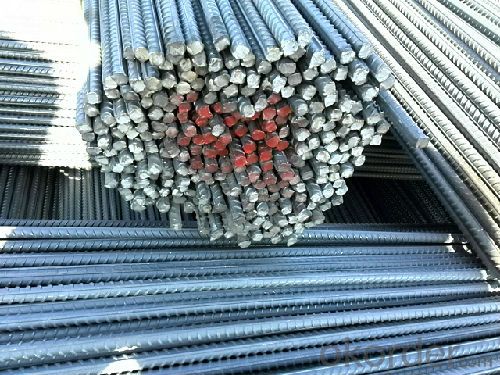
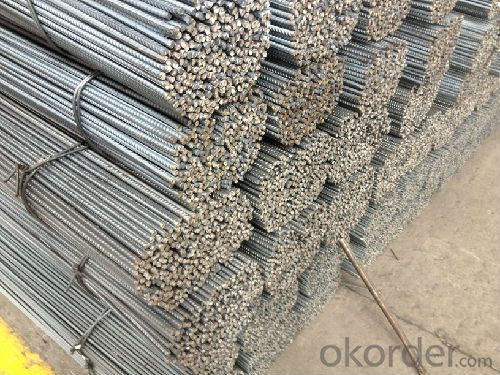
Packaging & Delivery of Hot Rolled Deformed Steel Rebars for Construction ASTM GR40,60
Packaging Detail: products are packed in bundle and then shipped by container or bulk vessel, deformed bar is usually naked strapping delivery, when storing, please pay attention to moisture proof. The performance of rust will produce adverse effect.
Delivery Detail: within 45 days after received advanced payment or LC.
Label: to be specified by customer, generally, each bundle has 1-2 labels
Note:
1. Our products are produced according to national standard (GB), if not, supply according to national standards (GB) or agreement as customer required.
2. Other Grade and Standard Deformed Steel Bar we can supply:
Grade: GR40/GR60, G460B/B500A/B500B/B500C,BST500S
Standard: ASTM, BS, DIN
The Minimum Order Quantity of these products is high, and need to be confirmed.
3. We can not only supply Deformed Steel Bar; if you need anything about building materials, please contact us for further information.
4. Please send us your detail specifications when inquire. We will reply to you as soon as possible. We sincerely hope we can establish a long stable business relationship.
FAQ:
Q1: What is the normal tolerance of Hot Rolled Deformed Steel Rebars for Construction ASTM GR40,60?
A1: Normally 3%-5%, but we can also produce the goods according to the customers' requests.
Q2: Can fit in the containers of 20fts the Hot Rolled Deformed Steel Rebars for Construction ASTM GR40,60?
A2: No proble, we can put them into the containers in the form sideling.
Q3: The products are invoicing on theoritical weight or on actual weight?
A3: We can do it in both manners, according to the customers' request.
- Q: What are the different types of steel rebars used in earthquake-prone regions?
- In earthquake-prone regions, several types of steel rebars are commonly used, including carbon steel rebars, stainless steel rebars, and epoxy-coated rebars. Carbon steel rebars are the most widely used due to their high strength and cost-effectiveness. Stainless steel rebars provide excellent corrosion resistance and durability, making them suitable for aggressive environments. Epoxy-coated rebars offer protection against corrosion and are often used in locations with high moisture content. The choice of rebar type depends on the specific requirements and conditions of the earthquake-prone region.
- Q: Can steel rebars be bent or shaped during construction?
- During construction, it is possible to bend or shape steel rebars. These rebars are commonly utilized in reinforced concrete structures to enhance their strength and stability. Although they are typically produced in straight lengths, they can be easily customized to fit the specific design requirements of the construction project. This adaptability allows contractors to reinforce different areas of the structure, including columns, beams, or slabs, by modifying the rebars. Specialized equipment, such as rebar benders or hydraulic tools, is usually employed in the process of bending or shaping the rebars. By doing so, construction professionals can guarantee that the reinforced concrete structure satisfies the necessary load-bearing and structural integrity standards.
- Q: How do steel rebars affect the overall construction cost of commercial buildings?
- The overall construction cost of commercial buildings can be significantly affected by steel rebars. These rebars, commonly used to reinforce concrete structures, play a vital role in guaranteeing the building's strength and durability. To begin with, the cost of steel rebars can directly impact the construction budget. Their price varies depending on market conditions and availability, and since they are an essential component in construction, their cost can directly affect the project's expenses. Additionally, the installation of steel rebars adds to the construction cost by requiring skilled labor and specialized equipment. Skilled ironworkers are necessary to accurately place the rebars according to the structural design. The labor cost associated with this skilled work can constitute a significant portion of the overall construction budget. Furthermore, the cost is also influenced by the quantity and density of steel rebars used in the construction. The structural engineer determines the necessary amount and spacing of rebars based on the building's design and load-bearing capacities. In certain cases, more rebars are needed to meet specific safety standards or withstand higher levels of stress. This increased quantity of steel rebars inevitably leads to higher material and labor costs. However, it is essential to note that the use of steel rebars is indispensable in commercial buildings to ensure structural integrity and safety. Although they may contribute to the overall cost, their benefits outweigh the expenses. Steel rebars reinforce concrete, enhancing its tensile strength and ability to withstand external forces like earthquakes, wind, and heavy loads. Ultimately, this results in a longer lifespan for the building and reduces the likelihood of expensive repairs or structural failures in the future. In conclusion, the cost of steel rebars impacts the overall construction cost of commercial buildings due to the cost of the rebars themselves, the labor required for installation, and the quantity needed based on the structural design. Nevertheless, the use of steel rebars is crucial to guarantee the strength and durability of the building, reduce long-term maintenance costs, and ensure the safety of occupants.
- Q: How do steel rebars affect the overall noise insulation of a structure?
- Steel rebars have a minimal impact on the overall noise insulation of a structure. This is because noise insulation primarily depends on the density and thickness of the materials used in the construction of walls, floors, and ceilings. Steel rebars, being used to reinforce concrete structures, do not significantly contribute to the sound insulation properties of a building. The primary function of steel rebars is to provide strength and stability to the concrete, ensuring its structural integrity. They are typically embedded within the concrete, resulting in their presence throughout the building's framework. However, the steel rebars themselves do not possess any sound-absorbing or sound-blocking characteristics. To enhance the noise insulation of a structure, other sound insulation materials such as insulation boards, acoustic panels, or soundproofing materials need to be incorporated into the building design. These materials are specifically designed to absorb or block sound waves, reducing the transmission of noise from one area to another. While steel rebars may not directly contribute to noise insulation, they indirectly play a role in maintaining the overall structural integrity of a building. A well-constructed and sturdy structure can help minimize vibrations and sound transmission caused by external noise sources. Therefore, while steel rebars themselves do not significantly affect noise insulation, their presence indirectly contributes to a more solid and stable building, which can help reduce structural vibrations and unwanted noise.
- Q: Can steel rebars be used in bridges?
- Yes, steel rebars can be used in bridges. Steel rebars are commonly used as reinforcement in concrete structures, including bridges. They provide added strength and stability to the concrete, making it able to withstand heavy loads and forces. The use of steel rebars in bridges helps to enhance their durability and structural integrity, ensuring the safety of the bridge and the people using it. Additionally, steel rebars have excellent tensile strength, which is necessary to counteract the tensile forces that bridges often experience. Overall, steel rebars are an essential component in the construction of bridges, contributing to their strength, longevity, and safety.
- Q: Can steel rebars be used in residential construction projects?
- Yes, steel rebars can be used in residential construction projects. Steel rebars are commonly used as reinforcement in concrete structures to provide tensile strength and prevent cracking. In residential construction, steel rebars are often used in foundations, concrete slabs, walls, and columns to enhance the structural integrity and durability of the building.
- Q: Does the grade three thread steel with "E" have the same information price as the ordinary three grade thread steel? Is there a big difference?
- As far as I know, the price of information may not be divided into "E" and "E", but there are mandatory requirements on the standard. It is estimated that the price will not be much different.
- Q: How are steel rebars installed in concrete?
- Steel rebars are installed in concrete by first placing them in the desired position and securing them with rebar supports or chairs. Then, the rebars are tied together using wire or rebar ties to ensure they are properly fixed and spaced apart. Finally, the concrete is poured over the rebars, covering them completely and providing structural reinforcement to the concrete.
- Q: What are the common quality tests performed on steel rebars?
- Steel rebars undergo several common quality tests to guarantee their strength and durability, ensuring they meet the necessary standards and can withstand the intended load and environmental conditions. The tensile test is one of the most prevalent quality tests for steel rebars. This test determines the maximum amount of tensile stress the rebar can bear before breaking, providing insights into its tensile strength and ductility. Another significant quality test is the bend test, which involves bending a rebar at a specific angle without it breaking. This test evaluates the rebar's flexibility, resistance to cracking or fracturing, and is particularly crucial for construction projects requiring bending or shaping. Chemical composition analysis is conducted to determine the percentage of various elements present in the steel rebars, such as carbon, manganese, phosphorus, sulfur, among others. This analysis ensures that the rebars meet specific requirements and do not contain any impurities that could jeopardize their strength or corrosion resistance. Corrosion resistance is also a vital property for steel rebars, especially in high-moisture or chemically exposed environments. A corrosion test is performed by subjecting the rebars to corrosive environments like salt spray or acidic solutions, assessing their resistance to corrosion. This test helps determine the rebars' suitability for specific applications and prevents premature degradation. Lastly, dimensional tests are conducted to verify that the rebars meet required dimensions and tolerances. These tests involve measuring the rebars' length, diameter, and weight. Deviations from specified dimensions can impact the rebars' structural integrity and compatibility with other construction materials. In summary, quality tests for steel rebars include tensile testing, bend testing, chemical composition analysis, corrosion resistance testing, and dimensional testing. These tests are crucial in ensuring the strength, durability, and suitability of steel rebars for various construction applications.
- Q: How do steel rebars prevent cracks in concrete?
- Steel rebars prevent cracks in concrete by providing reinforcement and increasing the tensile strength of the structure. As concrete is strong in compression but weak in tension, the rebars absorb and distribute the tensile forces throughout the concrete, preventing it from cracking under stress. The combination of steel rebars and concrete creates a composite material that can withstand bending, flexing, and other external loads, thus enhancing the overall durability and longevity of the structure.
Send your message to us
Hot Rolled Deformed Steel Rebars for Construction ASTM GR40, 60
- Loading Port:
- Tianjin
- Payment Terms:
- TT or LC
- Min Order Qty:
- 25 m.t.
- Supply Capability:
- 200000 m.t./month
OKorder Service Pledge
OKorder Financial Service
Similar products
Hot products
Hot Searches
Related keywords




